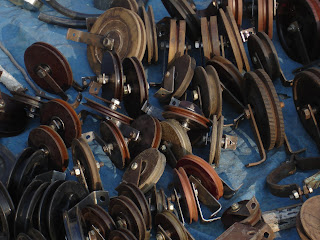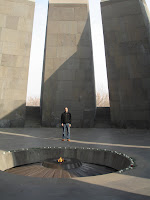On 19 Jan 2011, or last Wednesday I visited the Armenian Matenadaran Manuscript Museum in Yerevan at the recommendation of one of the host nation's coordinators. He was kind enough to assist me with directions, calling ahead for a tour guide, arranging a taxi and even assisting me by opening the taxi door! He has been extremely kind and helpful during this trip. The Matenadaran is impressive from the outside with large stone statues representing the great Armenian philosophers, historians, mathematicians and artists with a large one in the center representing Mesrop Mashtots.
The tour and entrance fee cost about 2,500 drams, the equivalent of about 8 dollars and what I learned from the tour experience was worth so much more. Whenever traveling I always try to pay for a tour led by a citizen of the country you are in, you learn so much! At the Matenadaran I learned all about the miniature art detailed on the various ancient manuscripts and the rules associated with the art and the penalties for breaking these rules. For example in Armenia you will not find a religious manuscript with an image the Holy Trinity (Father, Son and Holy Ghost) because in the Bible Jesus was the only one to see both the father and Holy Ghost together. When viewing the story of Genesis you can determine the country where the art was created based on whether the serpent has a human face or wings (characteristic of Greek or roman) or is represented simply by a serpent. Another way to identify the story of Genesis as coming from Armenia is if Adam and Eve are clothed or naked. In Armenia prior to eating the fruit of the tree of good and evil many miniatures represent them as clothed rather than naked. The Armenian thought process is that prior to the tree they were clothed in godliness and afterwards there were stripped bare, and often darker in skin though this darkening of the skin is not the current position of the Armenian church (as I was instructed).
I also learned of Armenia's strong religious heritage. One miniature in the museum demonstrated a battle and I was told at the time of this war the Persians were battling against Armenia and found that the best way to win the war was to convert the Armenian people to their religion. This religion was described to me as "aboriginal" the tour guides way of describing it is no longer an active religion. The tour guide explained that there was nothing dangerous in the religion the Persians were seeking to gain recruits for the bases of the belief was be good, do good and think good. By saying nothing dangerous I believe she meant nothing to contradict God however the Armenian's refused to convert unlike other neighboring countries that have since disappeared or been absolved into larger countries thereby losing their culture and history. She cited proudly that the Armenian people have never forsaken their faith and they belief that their current existence as a culture, country and people is credited to this faith in God. The guide was also very proud of their belief in an apostolic faith rather than Catholicism and the use of icons. She showed me several gospels with an ancient floral design in the margin as a seed and as the book progresses it becomes bigger and bigger. She said that the Armenians consider this to be the tree of knowledge and unlike the gospels of other religions that place icons in the margins the Armenians use this tree of knowledge to demonstrate as you read your knowledge grows and expands. She also explained how each of the four main apostles were represented by an ox/bull, lion, bird and a human face and that this is how they identify each gospel.
During the day I learned the origins of several different alphabets including the Armenian alphabet which is based on 36 different letters that each also represents a number. The alphabet was introduced around the 5th century and is arranged into 4 rows of 9. The 1st row represents 1-9, the second 10-90 and so on until they reach the 36th character. After the 36rh character a special character is introduced to continue increasing as the Armenian alphabet does not have a zero character. I also learned of the Armenian belief that National Spirit is worthy of more respect than any other politics. This was demonstrated in a work of miniature that shows one of their great scholars sitting on a chair near their King. The scholars chair was much larger to demonstrate that he is worthy of more respect than the politician. The Matenadaran also had secular books, though the predominant amounts of manuscripts are biblical. The tour guide indicated that the presence of these secular books is unique because at the time many Christian Churches had forbidden the translation of secular texts. Unlike these other Churches the Armenian Church allowed the copy and translation of secular texts which provides Armenian researchers with increased insight into the history of their country. I also viewed manuscripts on medicine, science and music and learned that the Armenians and their neighboring countries were some of the first to complete dissection and vivisection, believe that the earth was round and had a strong belief in herbal medicines. Unlike their western neighbors some scientists were expulsed by the Armenian Church for their scientific beliefs no one was killed for their beliefs.
 While touring the visit I tried very hard to understand what the different types of miniature art meant, which seemed to surprise the tour guide. I learned that there are two types. The first type is ‘elite’ or ‘aristocratic’ and is characterized by gold, deep intense color and rules regarding how it must fit within the page border and a Romanesque flair for details. The second type is ‘country’ and does not typically have borders or use gold and has less details and color. Within these two categories you may see miniature art that is a combination or type of ‘country’ or ‘elite’ that breaks the rules. Such as an ‘elite’ miniature art that does not follow normal border requirements, or a ‘country’ miniature art that has a detailed border. These "innovations" were typically frowned upon and considered to break the rules. Visit here for more details: http://www.kunstpedia.com/articles/illuminated-manuscripts-of-armenia.html#axzz1CXCLLXvn
While touring the visit I tried very hard to understand what the different types of miniature art meant, which seemed to surprise the tour guide. I learned that there are two types. The first type is ‘elite’ or ‘aristocratic’ and is characterized by gold, deep intense color and rules regarding how it must fit within the page border and a Romanesque flair for details. The second type is ‘country’ and does not typically have borders or use gold and has less details and color. Within these two categories you may see miniature art that is a combination or type of ‘country’ or ‘elite’ that breaks the rules. Such as an ‘elite’ miniature art that does not follow normal border requirements, or a ‘country’ miniature art that has a detailed border. These "innovations" were typically frowned upon and considered to break the rules. Visit here for more details: http://www.kunstpedia.com/articles/illuminated-manuscripts-of-armenia.html#axzz1CXCLLXvn Perhaps the most interesting part of the museum to me was the largest manuscripts in their collection. The manuscript called "The Homilies of Mush" weighed over 25 kilograms and its parchment was made from over 660 sheep. During the Genocide two women tried to save the manuscript by stealing it while fleeing the area. However the size (about 2 feet by 4 feet when opened) and weigh made it impossible and they slit the binding stealing only the half of the manuscript they could carry. The two women were caught and the manuscript half was taken by the Turks. Later the twentieth century a Russian had found the half that the women could not carry and provided it to the Matenadaran; this half is currently on display. The half taken from the two women who tried to preserve it was brought to the Armenians by a Turkish man and offered for sale it was purchased but the condition is so poor it cannot be displayed. This manuscript in particular spoke to me like none of the others because of its relation to the recent Genocide. I cannot imagine having to pay for a document that rightly belonged to my country and which had been taken by force from women who were most likely killed and the document in such bad shape that there was no doubt it had been badly abused. The idea seems so foreign and shocking to me that it makes me grateful to be an American, so privileged and blessed. That is the wonder of travel...learning about the big world so that you can appreciate your little world better.






























